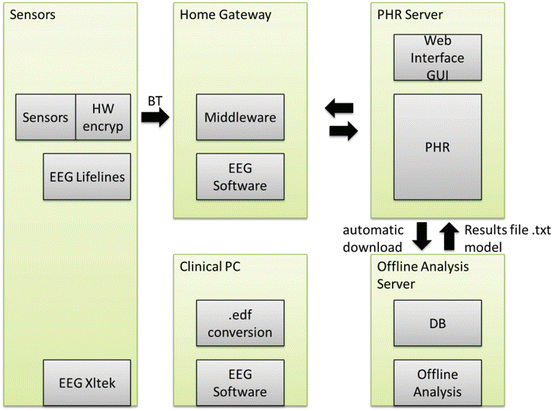Fig. 7.1
Architecture of the ARMOR system
The PHR server contains all the information related to the patients. When a new measurement shall be started the Home Gateway downloads a profile from the PHR. This profile contains the sensor configuration. Having this information, the middleware automatically configures the sensors and starts the measurement.
The sensors are streaming data via Bluetooth to the Home Gateway. The middleware fuses the data together, stores it, uploads it to the PHR server and also streams it to the Data Stream Management System (DSMS) where different algorithms can be applied.
The different monitoring parameters used for multipara-metric analysis include ECG, GSR, multichannel EEG and physical activity sensor (acceleration sensors) [5]. Furthermore there are some additional sensors providing context information about the measurement conditions and the patient’s environment. Temperature, air pressure, body position and a marker button need to be acquired and synchronized with the physiological data and then stored in a central database. The fact that for each patient some parameters are more important than others makes it necessary to adapt the system to the patient’s needs. Therefor the system was designed reconfigurable regarding the sensors. This means an individually selected set of sensors is attached to each patient profile in the PHR and the System uses only these required sensors to monitor the patient.
The DSMS runs different online algorithms to detect special events. Some examples are push button, alpha rhythm and seizure detection. These algorithms are also defined in the profile and can therefore be adapted to each patient individually.
The Event Manager handles the different events of special interest found by the algorithms in the DSMS. When an event is detected the event manager notifies the PHR directly, that can then inform the clinicians via SMS or e-mail about the patients state.
7.3 System Architecture and Interface Definition
Figure 7.1 shows an overview of the whole system architecture.
The sensor platform performs the following actions: data logging, data preprocessing, data encryption and wireless transmission of the assessed data to an aggregator for further analysis. A laptop used as an aggregator performs the data decryption (needed for the online analysis), processing and transmission to the Personal Health Record (PHR) database. The transmission to the PHR is realized by a standardized SSL secure internet connection. PHR includes all the legacy datasets of the patient as well. The offline analysis of the data is realized on the information server. Based on the offline analysis, the prediction models may be adjusted, thus creating a personalized monitoring system.
7.3.1 Hardware Components
The hardware of the systems can be divided in different modules that are shown in Fig. 7.2. Because of the modular architecture of the system, the sensors have to be configured regarding the individual requirements of each patient. Different types of sensors and from different manufacturers can be integrated in the system to be used on the patient. The connection to the system is done either by a wired interface or by wireless transmission of the data. The connection between the sensors and the central data base on PHR is realized by the home gateway, containing the system middleware and modules to handle sensors for offline recordings. The clinical PC is required for already existing medical equipment, such as the Xltek EEG system [6]. These clinical systems are often physically separated from the rest of other components, due to the IT-security restrictions of the hospitals. Hence for measurements with clinical devices and sensors located on the home gateway special attention has to be paid in terms of synchronization.


Fig. 7.2
Hardware architecture of the cyberphysical system
The central server of the overall system consists or two part, the PHR server and the offline analysis server. PHR server offers the possibility to store all the data from the patient in individual patient records and to access these data via a web based graphical user interface. To analyze the stored data, the offline analysis server downloads the data from PHR to perform the required analysis, restores the results in the patient record and modifies the patient profile according to the results of the analysis. This profile is used to configure the individual sensor configuration and the parameters for online analysis.
In wirelessly transmitting medical and highly sensitive data, security support is a prerequisite of primary importance. Respective support pertains to data privacy, data integrity and authentication of communication parties. However, provision of security features pose significant challenges in sensor network due to extremely limited resources in critical areas such as processing power, available memory and available energy. Furthermore, although Bluetooth Technology offers security features with respect to both authentication and privacy, at the same time respective weaknesses and vulnerabilities are quite well-known [7]. Additionally, significant overhead imposed by software security implementations as opposed to hardware implemented counterparts must be taken into consideration [8].
Stay updated, free articles. Join our Telegram channel

Full access? Get Clinical Tree








